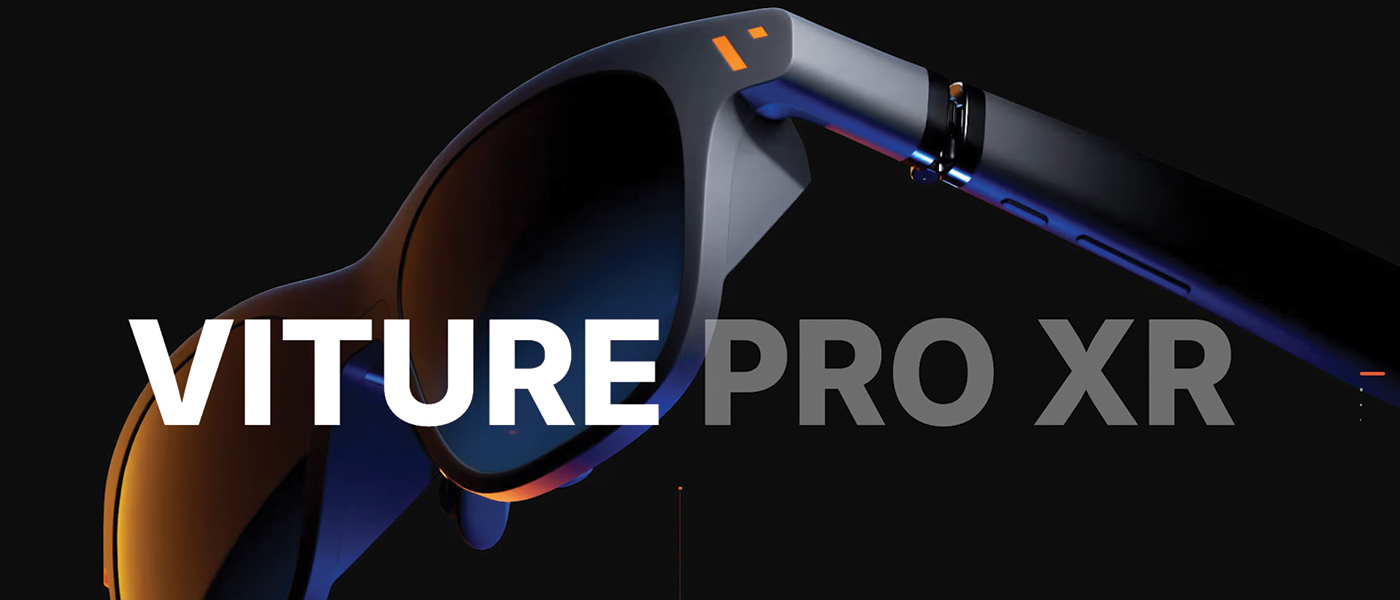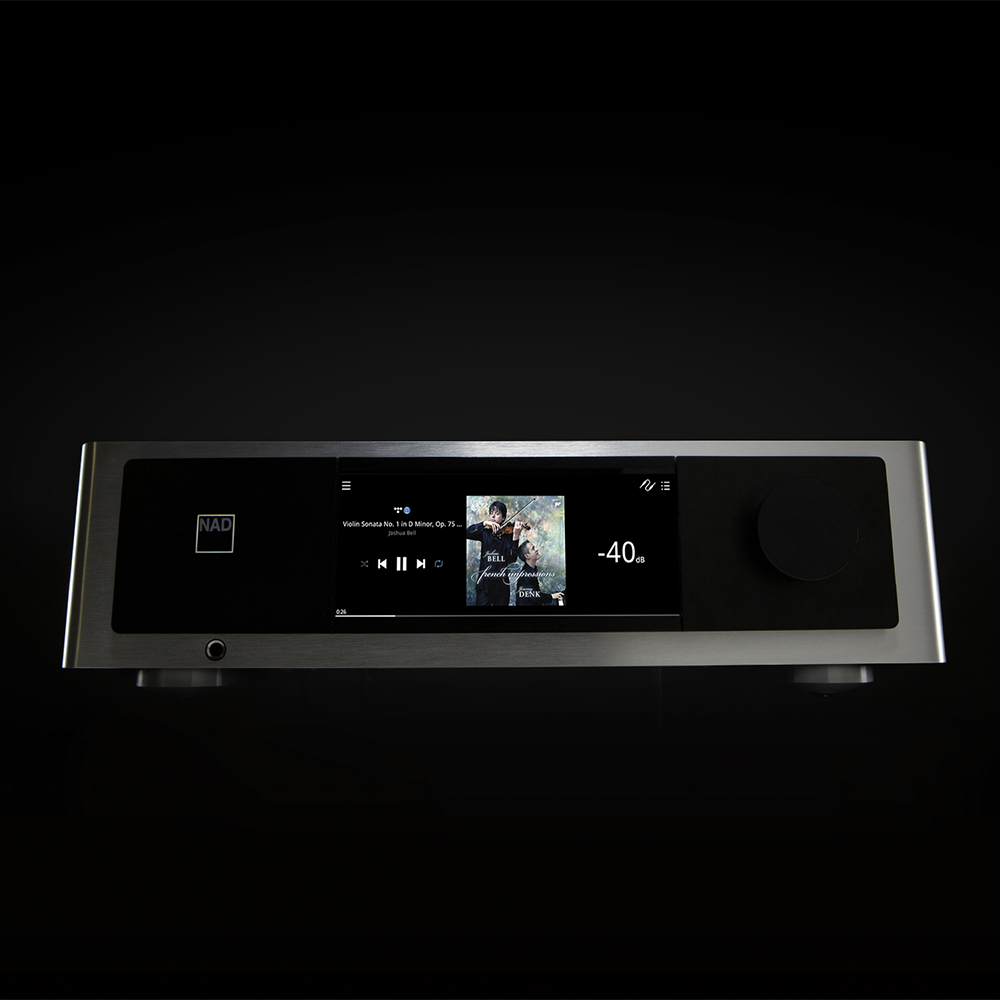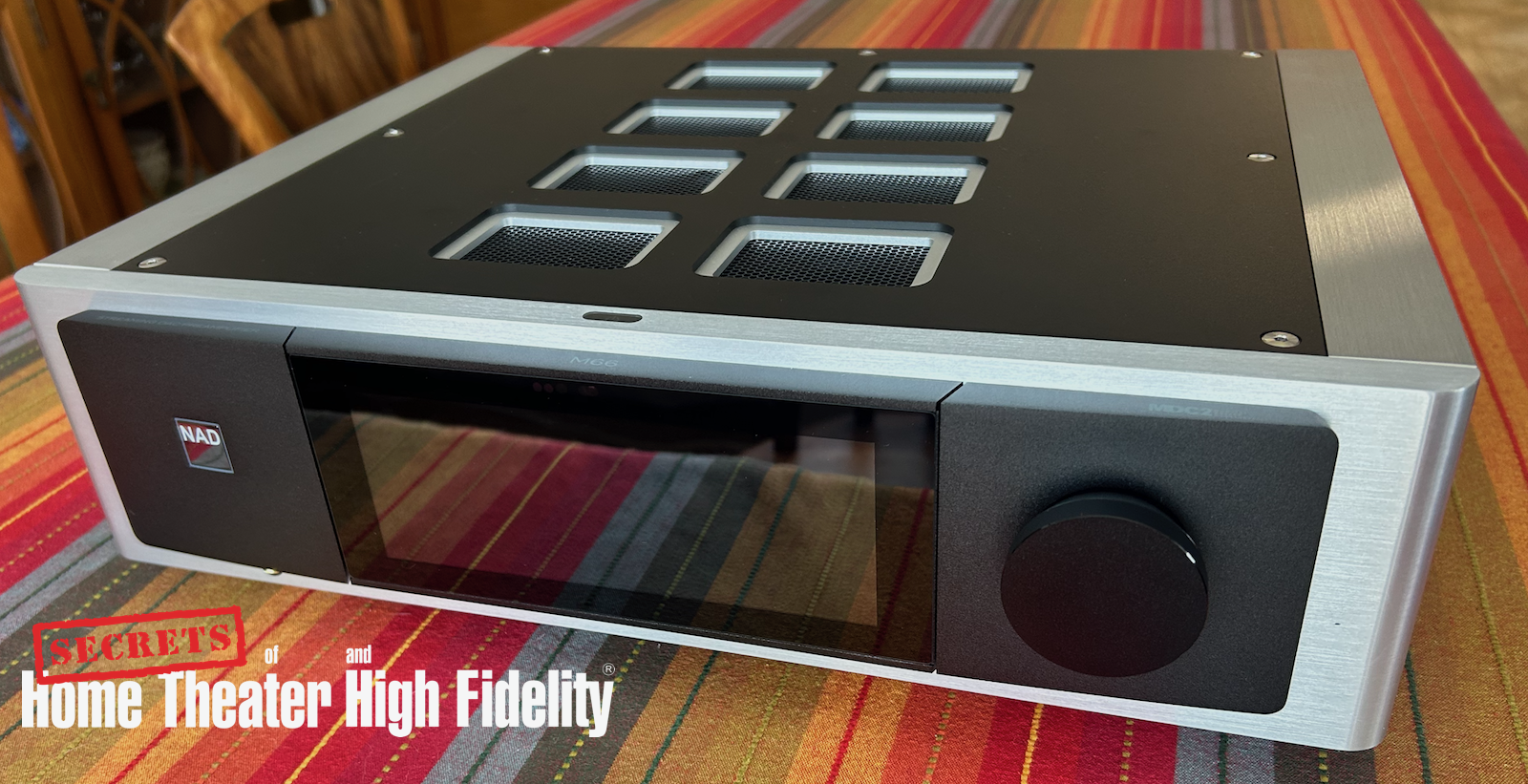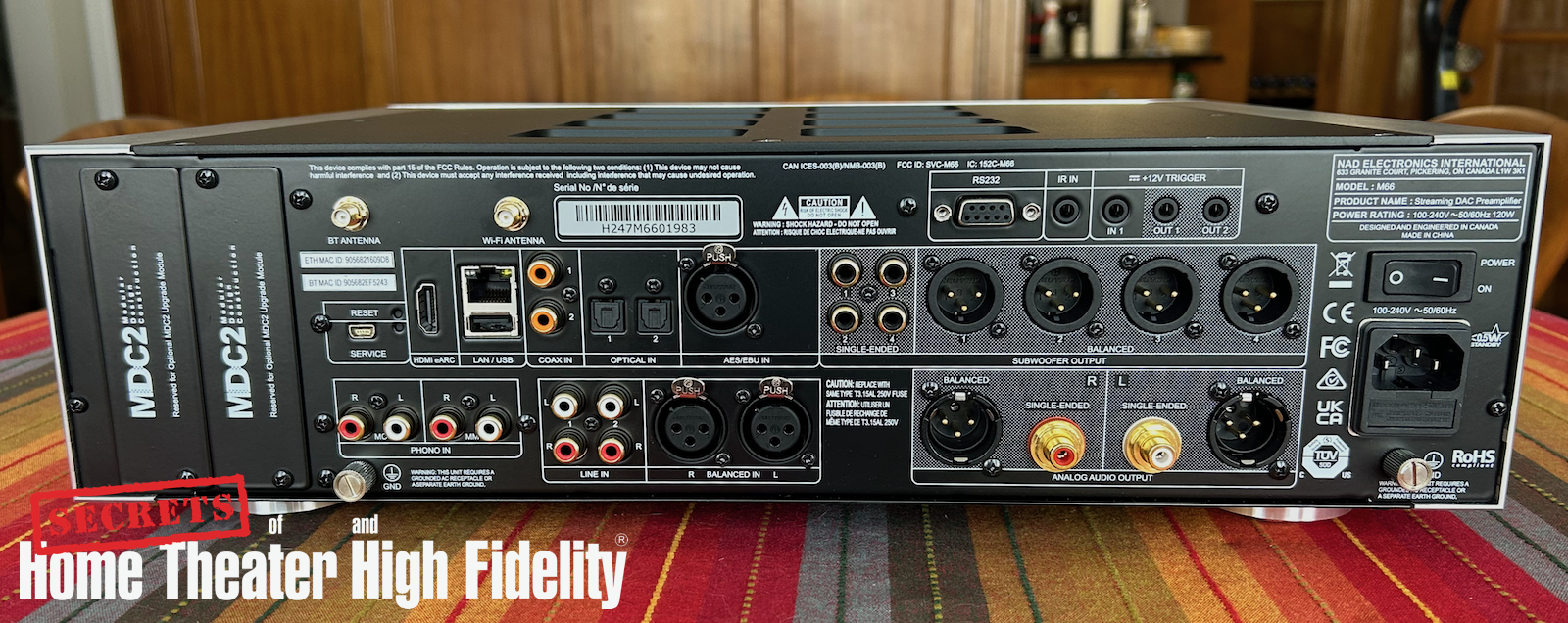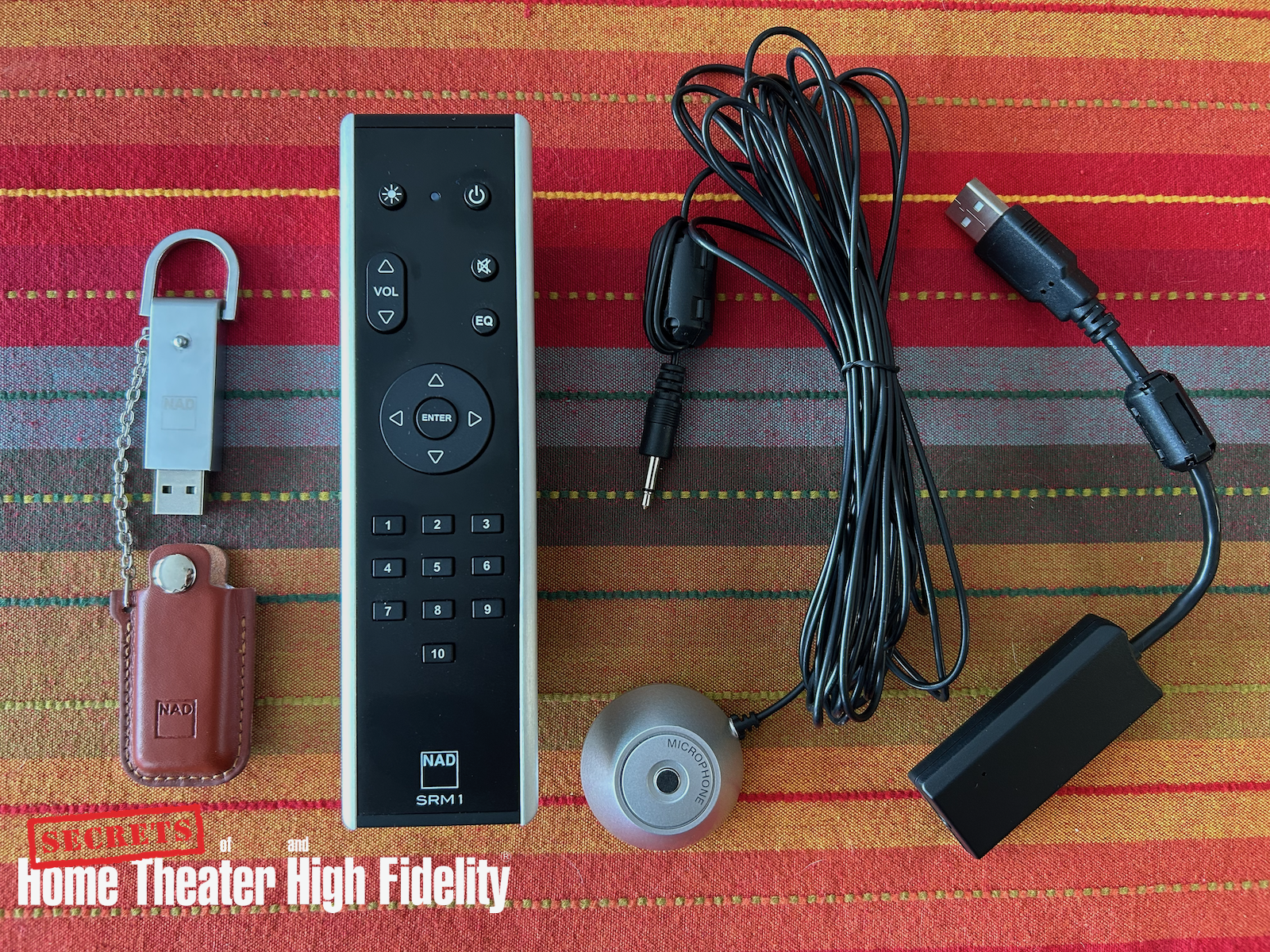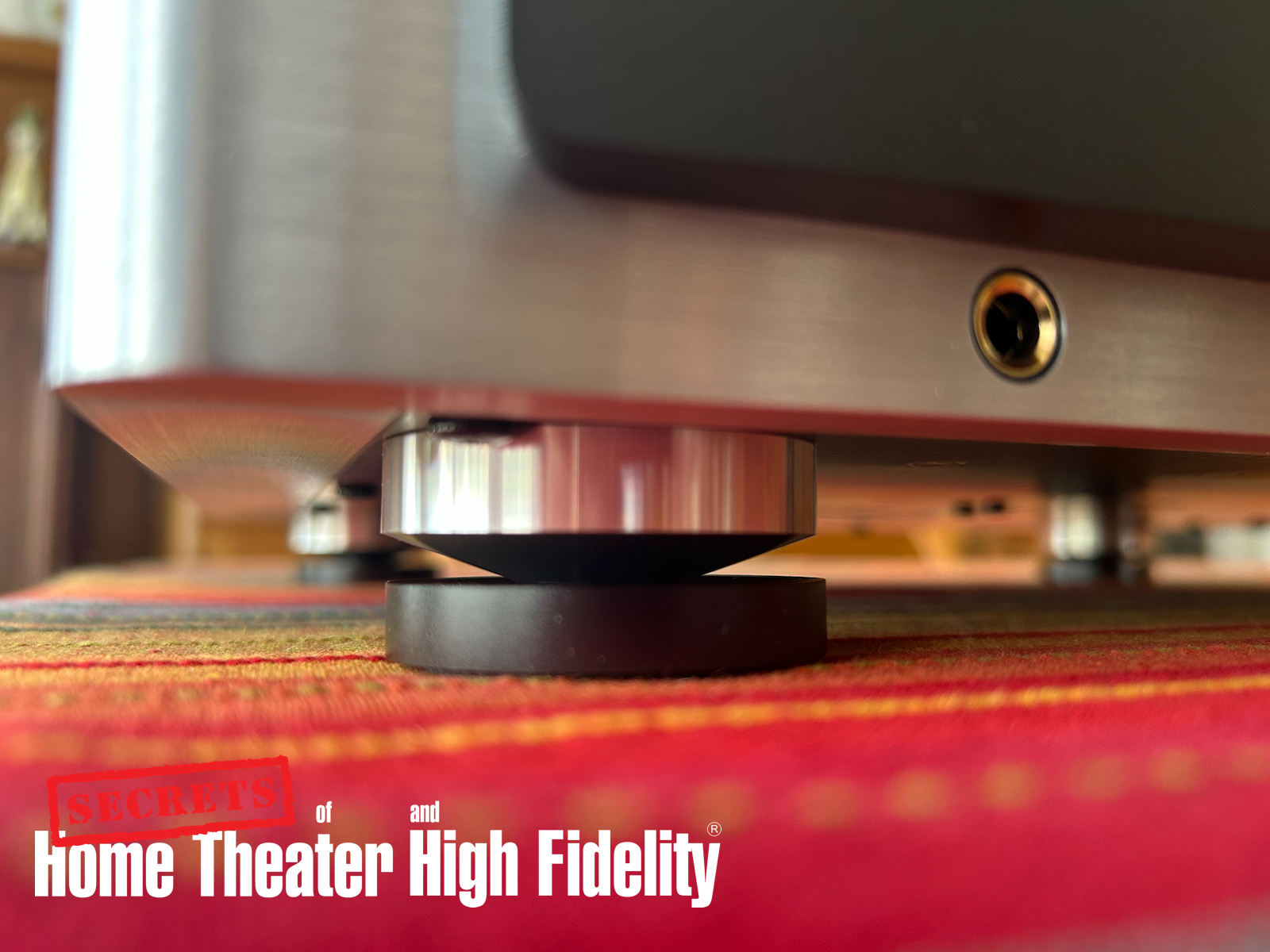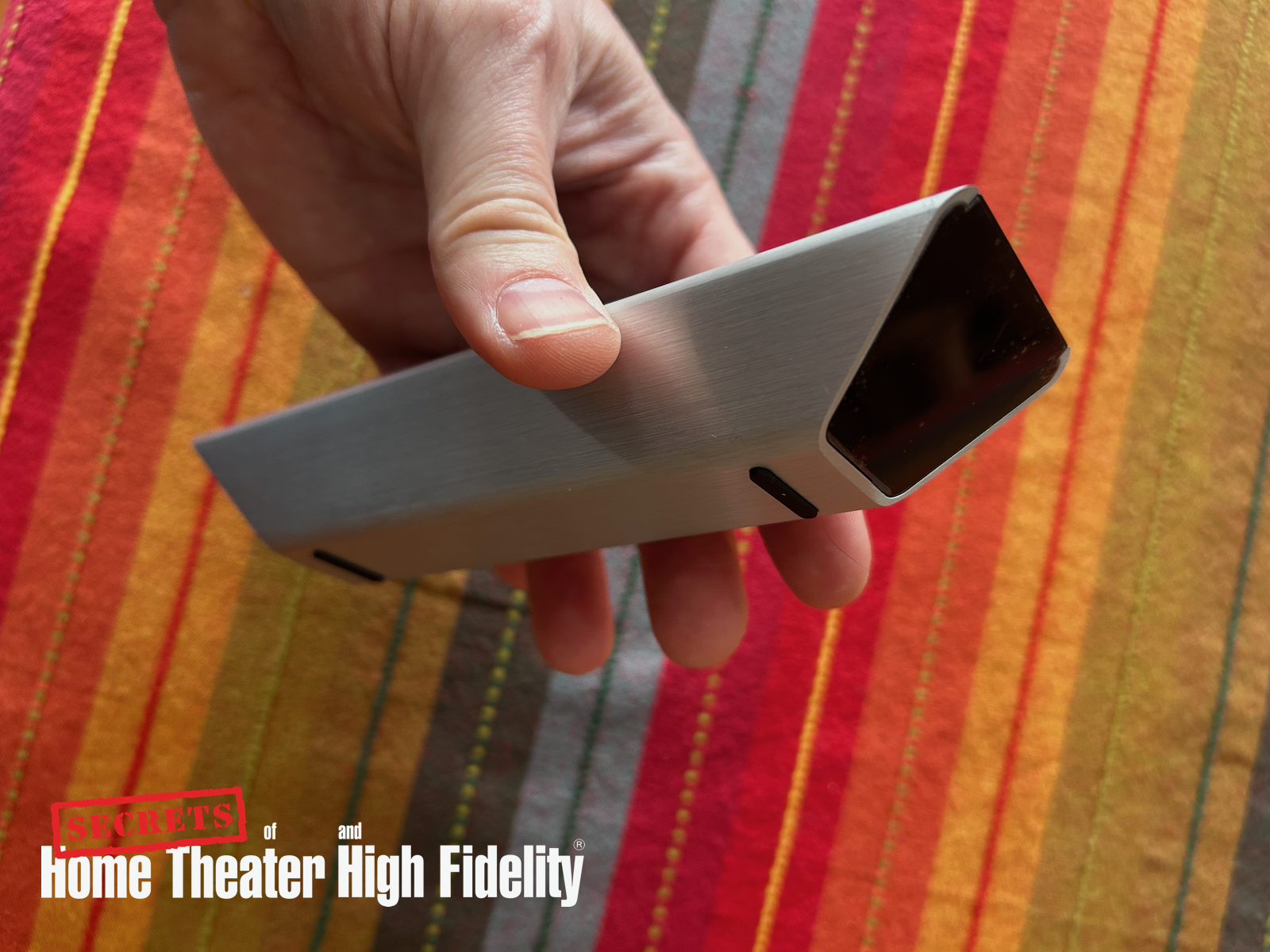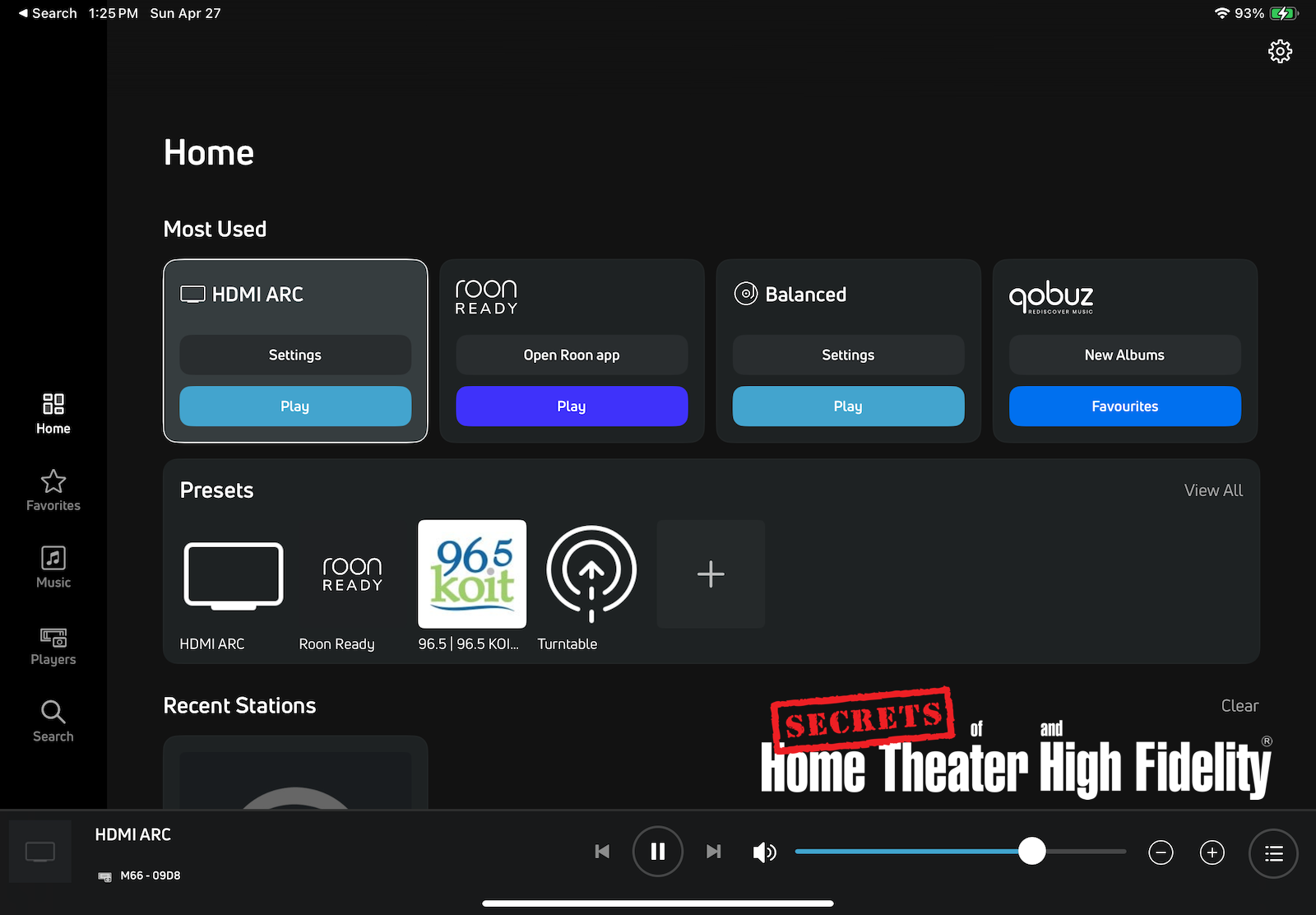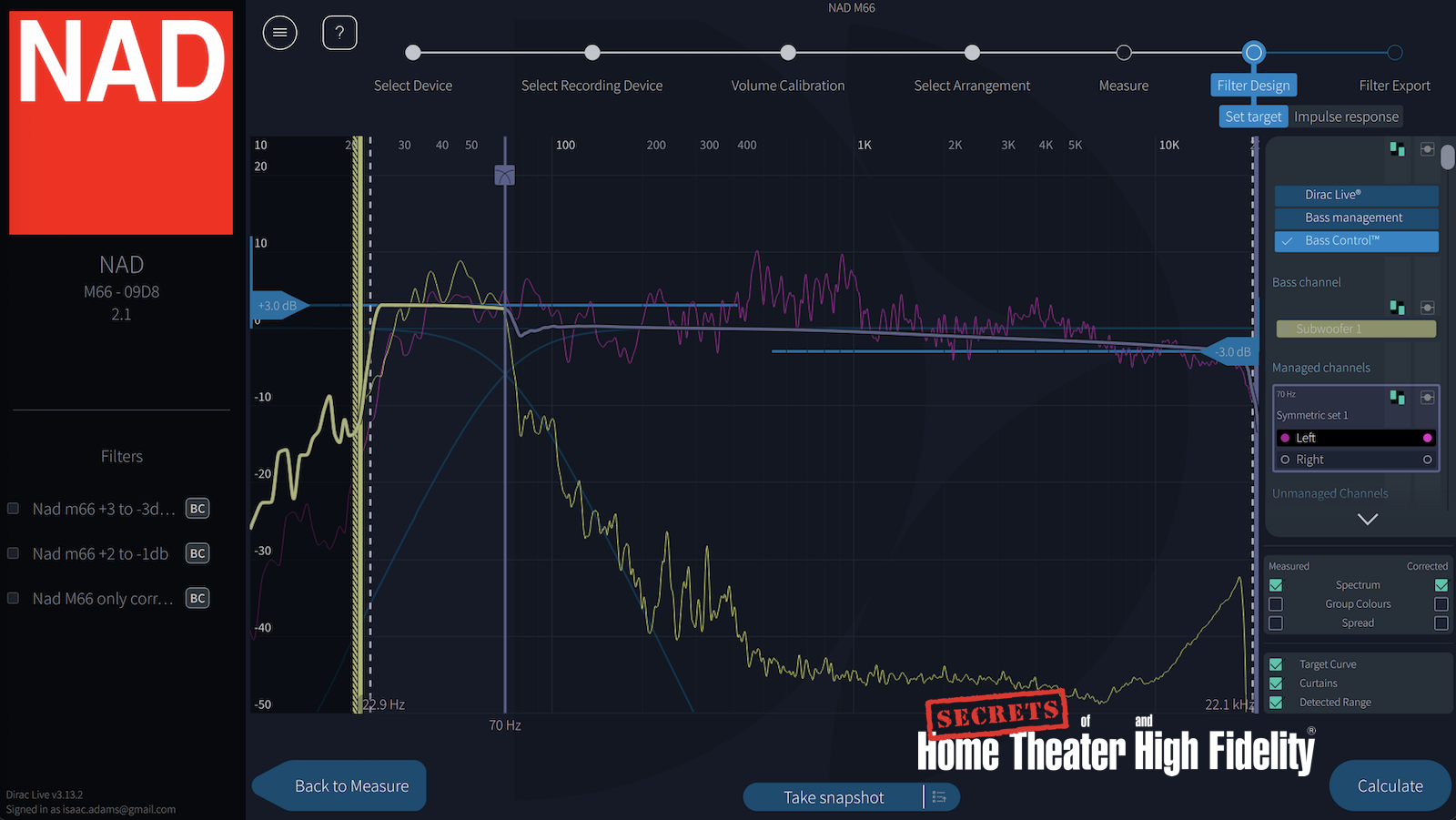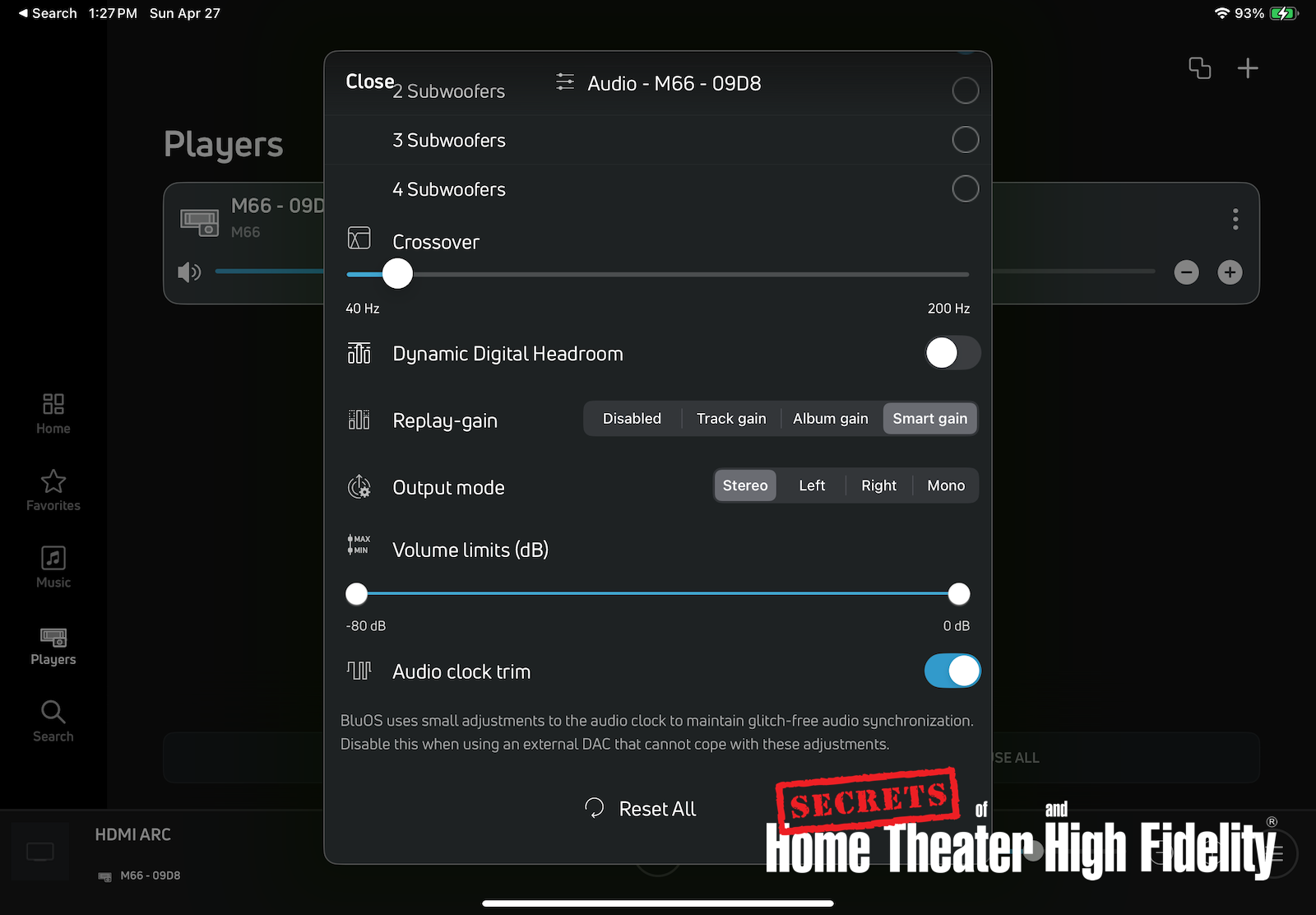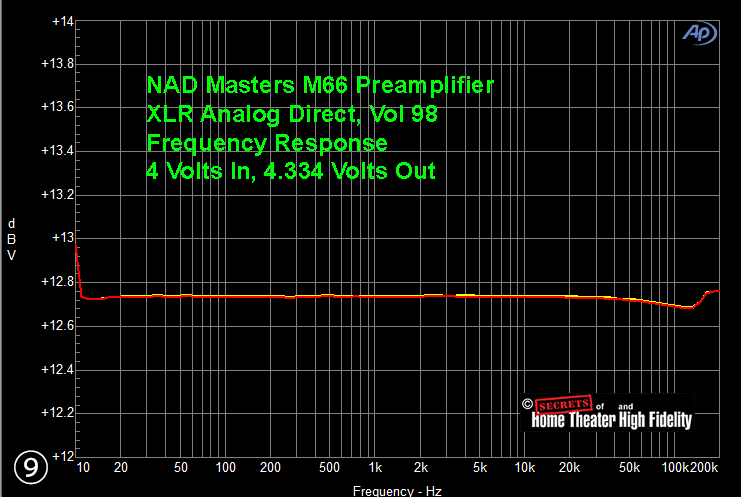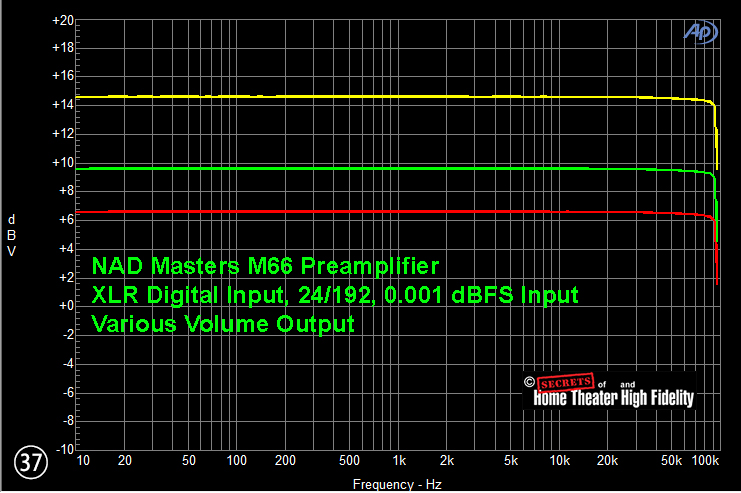By contrast, HiFi stereo products have largely remained a two-channel affair, but the NAD Masters M66 BluOS Streaming DAC-Preamplifier aims to change that.
The NAD M66 represents the top of NAD’s stereo product line and includes no less than four subwoofer outputs. While this might seem like overkill in what is otherwise a two-channel DAC Preamplifier, the M66 aims for reference-level performance, and NAD understands that high-quality, low-frequency reproduction is often the greatest challenge in most listening rooms. The NAD M66 features control by NAD’s BluOS operating system, which enables control by, and streaming from, mobile and tablet devices as well as wireless streaming to other BluOS-enabled speakers and Bluetooth headphones.
NAD Masters M66 BluOS Streaming DAC-Preamplifier
- Gorgeous high-end industrial design.
- Reference-level performance in both digital and analog passthrough modes.
- Attractive and functional touch screen with aesthetic touches like dual “analog” VU meters.
- Roon-ready, and support for a huge range of streaming music services via BluOS.
- Dirac room correction with full-frequency Dirac Live and Dirac Live Bass Control licenses included.
- Dynamic Digital Headroom for improved transients and noticeably better “heft and slam.”
- BluOS for control and streaming from almost any device or music service and to almost any Bluetooth-enabled speaker or headphone.
- HDMI ARC for use with a smart TV in a stereo-only home entertainment system.
- Balanced and unbalanced inputs and outputs to support a wide range of upstream and downstream equipment.
- Analog pass-through provides smooth, extended, grain-free sound that many audiophiles prize in vinyl and other analog sources.
NAD has been producing equipment since 1972, when it was founded in the UK by Marty Borish and Bjorn Erik Edvardsen. The goal of NAD was to demonstrate that it could deliver products with both high fidelity and high value. Through NAD’s history, the company has succeeded in producing many products that were both affordable and highly musical, and they have developed a loyal following based on this compelling formula.
In more recent years, NAD has introduced the Masters Series to show what it can do when it removes its self-imposed budget constraints and targets maximum performance. The NAD Masters M66 BluOS Streaming DAC-Preamplifier is its current statement stereo product and contains all of NAD’s knowledge about how to build high-performing products.
THD (20Hz – 20kHz):
<0.001% at 2V out
Signal-to-Noise Ratio:
>105dB (200 Ohm source; A-weighted, ref. 500mV out)
Channel Separation:
>120dB (1 kHz)
>120 dB (10 kHz)
Input impedance:
(R and C) 56 kOhms + 100 pF
Maximum input signal:
>5.6 Vrms (ref. 1% THD)
>8 Vrms (Analog Bypass, ref. 1% THD)
Output impedance Source Impedance:
+ 22 Ohms
Input sensitivity:
92.5 mV (ref. 500 mV out, Volume maximum)
Frequency response:
±0.2 dB (20 Hz – 20 kHz)
±0.2 dB (Analog Bypass, 20 Hz – 80 kHz)
Maximum voltage output (IHF load):
>10 V (ref. 0.1 % THD)
>20 V (Analog Bypass, ref. 0.1 % THD)
MSRP:
$6,999.00 USD
Company:
SECRETS Tags:
NAD, NAD Masters M66 BluOS Streaming DAC-Preamplifier, NAD M66, Dirac Live, Room Correction, Roon-ready, NAD Reviews, NAD Reviews 2025
Secrets Sponsor
The NAD Masters M66 BluOS Streaming DAC-Preamplifier is packaged in a handsome brushed aluminum case with a black top plate with eight rectangular cut-outs for ventilation that also provide a glimpse of the aluminum case underneath. The front of the M66 has a black face that protrudes from the front of the unit and is slightly smaller than the front profile of the aluminum case to which it is attached. Below the black face is a full-sized headphone jack that automatically mutes the other outputs when in use. At the center of this face is a large touchscreen that operates as the primary on-device control interface for the unit. To the right of the touchscreen is a large volume knob with an angled profile that turns smoothly with a slight mechanical resistance. At the top center of the frame, there is a small touch sensor that serves as the power switch. I found this sensor and its location somewhat non-intuitive, but it works fine when you get used to it.
The unit is supported by pointed feet that rest in supplied metal cups to prevent damage to the surface on which the unit is placed. These cups are also magnetic, which allows the unit to be picked up and moved without the cups falling off – this demonstrates great attention to detail and makes positioning the unit much easier than if the magnetic attachment were not provided.
Moving to the rear of the unit, we find a collection of balanced and unbalanced analog and digital inputs. The NAD M66 provides both moving-magnet and moving-coil phono inputs as well as one balanced and two unbalanced line inputs that can be assigned any name you choose via the BluOS control app. I used the iPad app, which I found relatively easy to use after an initial learning curve. NAD has provided two MDC2 module bays for potential upgrades to the M66, though the product information for the MDC modules currently listed on the NAD website does not explicitly indicate that any current MDC modules are compatible with the M66.
Balanced and unbalanced outputs are available for the two stereo channels and the four subwoofer channels, allowing excellent connection options for any configuration you might have. I especially like balanced outputs for subwoofers because they are often placed farther away, and the higher voltage and noise rejection of balanced connections are helpful to avoid the intrusion of 60Hz hum that can be picked up when line-level signals are routed near power cables.
The available connections are as follows:
● 1 ~ 12V trigger input, 2 trigger outputs
● 1~ HDMI eARC input
● 5 ~ digital inputs – 2 S/PDIF Optical, 1 AES/EBU, and 2 RCA S/PDIF
● 1 ~ USB audio input (used for measurement mic interface)
● 2 ~ stereo unbalanced analog inputs
● 1 ~ stereo balanced analog input
● 2 ~ stereo unbalanced phono inputs
● 1 ~ Moving magnet (low gain)
● 1 ~ Moving coil (high gain)
● 1 ~ RJ-45 ethernet
● 1 ~ RS-232 serial connection
● 1 ~ 1/4” headphone output (on the front)
● 2 ~ chassis grounds
● 2 ~ MDC2 module slots for future upgrades
Of particular note are the analog inputs – all feature an analog passthrough, bypassing digital AD/DA conversion and Dirac entirely to keep the signal fully in the analog domain while retaining subwoofer outputs. When used in analog bypass mode, these connections are rated to have an extended bandwidth of 20Hz-80kHz, compared to 20Hz-20kHz when digital conversion is applied. While these are the stated specifications, we’ll talk later about how these conservative ratings don’t tell the M66’s full story.
The NAD M66 was shipped in a double box with a well-designed cardboard “clamshell” insert providing great protection during shipping and an easy unpacking experience. The packaging is made of recyclable materials, demonstrating an awareness and commitment to sustainability.
The M66 includes a microphone for Dirac calibration, a very upscale USB drive in a small leather pouch, two power cords (one for US, and one for European and Asian markets), a remote control, and four cups on which the pointed cone feet of the unit should be placed to both acoustically decouple the unit from the surface on which it is placed and protect the surface from damage. One thoughtful and very functional design element of these cups is that the cone-and-cup system is magnetic, allowing secure attachment of the cups to the cone feet before positioning. Some care is still required to ensure the cups don’t detach when moving the unit, but this design makes placing and repositioning the NAD M66 much easier and less fussy than it would be if the feet weren’t magnetized.
The NAD M66 SRM1 remote has an unusual trapezoidal design with a quirkiness and personality that will be familiar to those who own equipment from other high-end brands. The remote has a 2-tone black and brushed aluminum appearance that matches the main chassis of the preamp, and it has a weighty, high-quality feel. The remote generally works well, but I found the edges rather sharp, perhaps to the point of being a little dangerous to handle at times – smoothing the edges a tiny bit would make the remote more pleasant to hold and safer to use.
Connecting the NAD M66 was similar to the experience of connecting my usual home theater setup, just with fewer output channels and HDMI connections. The NAD M66 can be configured via the touch screen on the front panel, but I opted for configuration via the BluOS iPad app. For viewing, I connected my LG smart TV via the HDMI eARC connection and used the internal LG apps for YouTube TV, Apple TV, Apple Music, and other video streaming services. I selected Roon for the second input, a local radio station for input 3, and my turntable connected via the balanced analog inputs for input #4. Because my turntable is about ten feet away from the rest of my system, I did not use the M66’s phono inputs, instead using the balanced outputs of my Musical Fidelity M1ViNL due to the somewhat long cable run.
The NAD M66 includes licenses for a comprehensive Dirac suite of room correction software, including full-bandwidth Dirac Live and Dirac Live Bass management. Since these products have been covered extensively in other reviews, I won’t spend time here on the Dirac configuration process. I will say that I found the M66 sounded better without Dirac enabled. If you have a system that is already well-calibrated, I would recommend using the M66 sans-Dirac as the output level is higher (when enabled on the M66, Dirac reduces the output level quite a bit), and the sound is more natural. Dirac also operates in the digital domain, so it won’t help when using the NAD M66’s fantastic analog bypass mode. If you mostly listen to digital sources and your system has an unacceptably uneven response without room correction, Dirac can be used, and the implementation on the M66 is very good. As a compromise, if your system only needs help in the low frequencies to conquer room modes and manage multiple subs, you may employ Dirac just at low frequencies to avoid negative impacts on voices, instruments, and other material sensitive to Dirac’s processing.
Though not as hassle-free as wireless connection via BluOS, hardwired connections are easy with the M66 – you simply need to make all of the channel connections, select the number of subwoofers you have, and pick a subwoofer crossover frequency. For most of my listening, I chose 50Hz because my mains are flat to around 30Hz and they only need a little help at the bottom end of the range.
The following equipment was used with the NAD M66 in this evaluation:
Upstream:
● LG OLED77A2PUA 4K UHD TV
Comparison:
● Meridian G68
Downstream:
● EAD Powermaster 500 Power Amplifiers (x 2)
● miniDSP 4×10 HD
● 3-way custom-built active loudspeakers with Morel and Scan-Speak drivers
Digital:
Given that the NAD M66 is marketed as a streaming preamp, it made sense to start the evaluation with digital material. With any device capable of first-class Roon support, I always prefer Roon because the user experience and sound quality are generally better than any other options. Regarding BluOS, Editor Emeritus, John Johnson, has already extensively covered the BluOS platform using this very NAD M66 unit, and you can read his impressions here.

Billie Eilish, “When We All Fall Asleep, Where Do We Go?”
I first became aware of this song when attending a local San Francisco Bay Area head-fi meetup. I had been listening to the usual HiFi audition tracks I was familiar with, and noticed this song was on the player when I sat down at a station with a pair of Stax SR-009 headphones paired with the outstanding Stat Electrostatic Headphone Energizer from Bottlehead. I had heard very good sound that day from other systems, but I felt most systems were either too “lean” and thin, or too “bass-heavy”. When I started playing Billie Eilish’s “Bad Guy” on the Stax/Bottlehead setup, I was blown away by the weight and articulation in the upper bass of the synthesized music and the intoxicating combination with Eilish’s breathy vocals. This system sounded detailed, powerful, and effortless, the way a live concert can sound if it’s mixed well and the PA is very good.
“Bad Guy” is positioned as something of a low-fi track, but it’s very revealing of how a system presents upper bass, and I found it’s very good at shining a spotlight on how different systems present the crucial 50Hz-120Hz range. On the NAD M66, I found the presentation similar to that awesome Stax/Bottlehead system – very forceful through the upper bass, but velvety smooth and natural elsewhere. While auditioning this track, I discovered the “Dynamic Digital Headroom” setting on the M66. With this setting enabled, the impact and weight were further intensified, and the overall sound was even closer to a live concert experience. Without “Dynamic Digital Headroom,” the sound was full; with it, I could physically feel the impact and lower frequencies, and I got a much more “you are there” presentation. Good stuff.

The Cars, “Candy-O”
The music of The Cars represents the soundtrack of the lives of many people coming of age in the 70s and 80s. When the weather turns warm, and I’m in the mood to get on the road, I find myself reaching for The Cars.
This iconic band had many hits, but I think “It’s All I Can Do” from the album “Candy O” is perhaps the perfect example of The Cars’ signature sound. This song features Rick Ocasek’s signature vocals and arrangement, soaring synth tones that overlap with and hand off to beautifully matched guitar solos, and very well-mixed, punchy percussion that comes in with authority to back it all up. On lesser systems, the upper midrange and treble can become “shouty” and harsh, and the bass and percussion can be weak and anemic. On the NAD M66, especially with “Dynamic Digital Headroom” enabled, the music was delivered with authority; simultaneously weighty, punchy, detailed, and smooth. I listened to this track several times during the auditioning of the M66, and it always brought a smile to my face.
Analog:
Since the turn of the last century, when my wife gave me an engagement gift of a Meridian 561 Digital Surround Controller, I’ve been in the digital surround processor camp. I first heard Meridian equipment at the then-preeminent HiFi Buys store in Atlanta, Georgia, and I was smitten. I listened to many systems there, but the Meridian room was consistently the best sound I heard, and it was thereafter what I aspired to own. There is a subset of the audiophile community that has remained committed to 2-channel analog signal paths, but I felt that Meridian’s well-implemented digital, especially when combined with DSP and surround processing, was good enough to match, and often better, analog sources and systems. In recent years, I’ve enjoyed rediscovering vinyl, but I’ve never felt that my digital signal chain was holding back the overall sound quality because I could easily hear the differences when making changes to analog sources. The NAD M66 forced me to reconsider that position, at least in part.
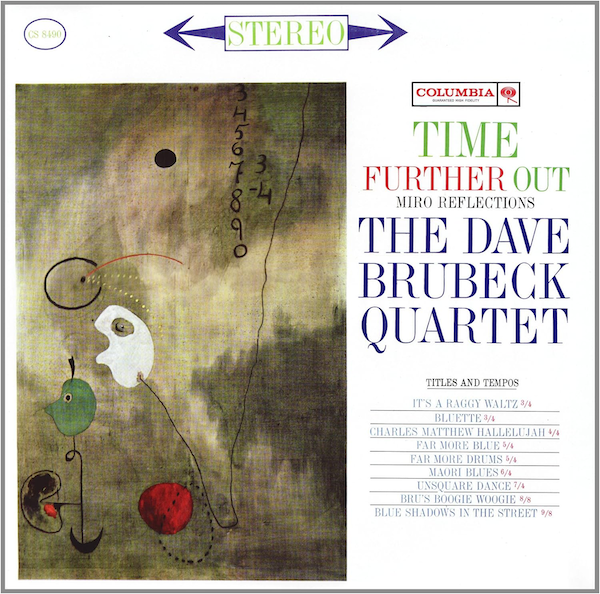
The Dave Brubeck Quartet, “Time Further Out”
The Dave Brubeck Quartet’s outstanding “Time Out” album was my first exposure to this iconic group’s sound. This two-mic recording provides an excellent sense of ambient space, and it made me aware that sound quality over the years was not a steadily increasing, linear trend line. There were, indeed, vintage recordings that sounded fantastic and newer recordings that sounded awful. “Time Out” is one of several excellent recordings from the late 1950s that deliver an outstanding musical performance and exceptional sound. “Time Further Out” is a sequel that, in many ways, provides even better sound than “Time Out” and has a couple of test tracks that deliver unique acoustics and very high-fidelity sound.
The opening track on side two, “Far More Drums”, is a phenomenally well-recorded song with piano, bass, and, as promised, a lot of drums. The drums and cymbals on this track are the stars of the show. This recording sounds good on most systems, but it can truly shine on a high-end system. The NAD M66 in analog bypass mode stunned with its ability to throw a wide soundstage and produce high frequencies utterly free of grain and strain. I’ve heard smooth highs on other systems, but never “perfect” highs like what I heard with the M66. The clarity and silky smoothness of the M66 in passthrough mode revealed that despite the M66’s excellent ADC utilized to digitize analog inputs, a pure analog signal path as implemented in the M66 can clearly, audibly surpass its own very well- implemented digital signal chain with analog sources. For digital sources, the sound quality difference is less apparent, but on analog sources, I’d wager almost anyone could hear the difference and would prefer the sound of the analog passthrough option.

George Benson, “Give Me the Night”
George Benson’s contribution to the 1970s and 1980s jazz scene is undeniable, and the title track of this album is a true jazz fusion classic. From the opening notes, this song has a rhythmic, cool vibe that captivates even the uninitiated. This song swings with a reverberant backing vocal track that adds fantastic depth to the song, and the recording pulls out some unique stops that give it a singular sound.
In the middle of the song, the sound collapses into a cappella vocals that sound like they were recorded in a reverberant space, like a stairway or another similar enclosed space with hard surfaces. This reverberant acoustic environment combined with a minimal, collapsed mix produces a haunting sound with a huge spaciousness that is unique in my experience. This track produces a soundstage that is limited only by the ability of the equipment reproducing it, and the M66 does a wonderful job conveying this sound field. If you’ve never heard this track on a good system, you owe it to yourself to give it a try – you’ll probably revisit it many times.
General Listening Impressions
As I’ve done before, I’ll use the following system to describe the sound of the M66:
● Speech and instrument intelligibility – how easy is it to understand spoken dialog? Can you hear individual instruments and notes, or is the sound field a jumbled mess?
● Sense of “weight” and “authority” – across the frequency range, is the sound realistically dynamic and vivid, or dull and lifeless?
● Delicacy and smoothness of high frequencies – is there artificial grain or harshness in high frequencies, or are sibilances and high-frequency content presented naturally as in real life?
● Clarity of midrange – do voices sound natural and clear, or is there something strained or fatiguing about them?
● Transient response – are instruments like drums and bass presented with a sharp, percussive attack, or are the notes flat and sluggish?
● Sonic flexibility – do different recordings sound appropriately different, or do they all have a common “house sound” imposed by the system?
● Does it sound good? – Regardless of the above, do I like what I hear? Do I want to listen more, or is the sound boring or irritating?
Here’s how the NAD M66 measures up:
Speech and instrument intelligibility: 10
The NAD M66 is superbly detailed with great balance across frequencies and an uncanny ability to deliver black backgrounds and inner details. These traits make it extremely easy to hear individual voices, instruments, and subtle variations in great recordings, even when these parts are much quieter relative to others. I routinely heard backup vocals and spoken words beneath the music in tracks that were much more clearly rendered than I was accustomed to. If you delight in hearing musicians talking to each other between songs or in hearing the subtle details of great backup vocals, the M66 is great at revealing those details.
Sense of “weight” and “authority”: 10 digital, 9 analog
I can’t think of a two-channel preamplifier I’ve heard that has as much low-frequency authority as the NAD M66. Part of this prowess is certainly a function of the numerous subwoofer outputs that let you flood your room with copious amounts of bass, but you don’t need a subwoofer to experience the authority of the M66’s presentation. Everything sounds very solid through the M66, and the “Dynamic Digital Headroom” setting turns that up to 11. I found this powerful presentation helped pop and rock music the most, but it also gave added impact to orchestral works and jazz with large amounts of low- frequency content (tympany, organs, etc). This feature seems almost tailor-made to extract the maximum power from the recordings of labels like DMP and Telarc. If you like dynamic range, the M66 with a high-quality digital source in dynamic digital headroom mode will deliver it in spades.
Delicacy and smoothness of high frequencies: 9 digital, 10 analog
On digital material, I’d rate the M66 a 9 out of 10, but when switching to the analog passthrough mode, I have to give the M66 a perfect 10 in high-frequency reproduction. I’ve tried equipment with an analog passthrough function that didn’t sound much different from the ADC/DAC signal path. The M66 is a different beast; even if you never used any of its digital features, the M66 would serve as a stellar reference-level analog preamplifier. I have long thought that my turntable cartridge or phono preamplifier had some minor flaws that introduced minor grain or harshness that was just part of analog sources. The NAD M66 showed me that there was, indeed, no such problem – my turntable, cartridge, and phono preamplifier were capable of near-perfect high-frequency reproduction.
Clarity of midrange: 9
I would consider the midrange of the M66 very good, with a very natural, but somewhat dark tonality. The M66 isn’t warm, but it’s not cold or dry either. The M66’s midrange draws little attention to itself, which probably means it’s just “right”, but I wouldn’t consider it particularly “transparent” or “open”.
Transient response: 10 digital, 9 analog
In digital mode with Dynamic Digital Headroom enabled, I would give the NAD M66’s transient response a 10, but in analog passthrough mode, I would rate it a 9. I found little to criticize, but feel that analog transients are a tiny bit less sharp than I’ve heard in some other systems. The analog passthrough mode does not add anything, which is to say that its performance is very good without any sort of enhancement of transients or dynamics.
Sonic flexibility: 8
The NAD M66 shows most of its flexibility in the low frequencies, where it ranges from tame to explosive depending on the recording. At mid and high frequencies, this versatility is more limited and more subtle. At higher frequencies, the M66 delivers a very consistent, controlled performance with tons of detail but without the chameleon-like qualities it demonstrates at lower frequencies. This consistent delivery never disappoints, but also rarely amazes.
Does it sound good?: 9
What isn’t up for much debate is that the NAD M66 sounds very good, indeed. On some tracks, especially those with a lot of deep and dynamic bass, you couldn’t reasonably ask for more or better. On tracks with more acoustic material with less bottom end, you will get a truthful performance that is highly detailed and extremely consistent. Across all of the listening I did with the M66, I found nothing that sounded bad, though I found some recordings that didn’t sound as impressive as I’d heard them sound on other systems. It’s entirely possible that I was missing the additional channels and surround processing modes I’ve become accustomed to, and that the M66 is about as good as it gets with stereo reproduction. That’s especially true when you evaluate the M66 with excellent analog program material in passthrough mode.
I did not perform bench tests as a part of this review because our Editor-in-Chief Emeritus. John E. Johnson, Jr., has already done a superlative job of that in his review of the M66 focusing on its BluOS capabilities. Here, I’ll reference a couple of his measurements that I think explain the reasons the M66 is so special and how I think NAD has been (perhaps overly) conservative in stating the specifications of the M66.
In this measurement, we see that despite the 20 Hz-80 kHz specification of the M66, it’s essentially flat from 12 Hz-200 kHz+! I think this amazing performance is one of the reasons the M66 is so fantastically smooth with analog sources. In the audible frequency range, the M66 isn’t breaking a sweat, and it should easily be able to produce not only fundamental frequencies in the audible range but also 2nd-5th harmonics beyond that. I personally feel that capability is the secret to producing highs without any sign of harshness or unnatural sibilance.
The NAD M66 is rated flat from 20-20 kHz with digital signals, but in the above graph, we see that digital signals at a sampling frequency of 24/192 kHz offer flat frequency response from 10 Hz to 96 kHz. I noticed that on well-mastered digital recordings at very high sampling frequencies, the sound had a smoothness that was nearly as good as what I heard in the analog bypass modes (but not quite perfect).
Secrets Sponsor
The NAD Masters M66 BluOS Streaming DAC-Preamplifier offers unique features, delivered masterfully, for a price that is reasonable given what you get.
- Superlative stereo sound with impressive low-end authority
- Actual performance that far exceeds conservative specifications
- Great display with excellent touch interface and visuals
- Pure analog signal paths that are among the best I’ve heard
- Versatile connectivity, including balanced, unbalanced, and wireless I/O
- Good looks and sturdy construction
- Flawless Roon implementation
- BluOS control from mobile and tablet devices
- An option to increase the 15-minute limit on the auto power-down timer when no signal is detected
- Flexible configuration of the six analog outputs with more EQ and crossover options, allowing 2- and 3-way active speakers
- Options for higher sampling frequencies if Dirac is disabled
- Power on/off from HDMI CEC commands. Roon can wake the unit from a power-down state, but HDMI smart TVs cannot
- A remote with edges that are not as sharp
The NAD Masters M66 BluOS Streaming DAC-Preamplifier is not the first component I’ve heard that attempts to deliver reference digital and analog performance in a single package, but it might be the first component I’ve heard that truly succeeds in this endeavor. At $6,999, this is not a cheap streaming preamp, but I feel at this price it’s something of a bargain. If you want great stereo reproduction with industrial-strength low-frequency reinforcement, the NAD M66 should be on your short list to audition.


